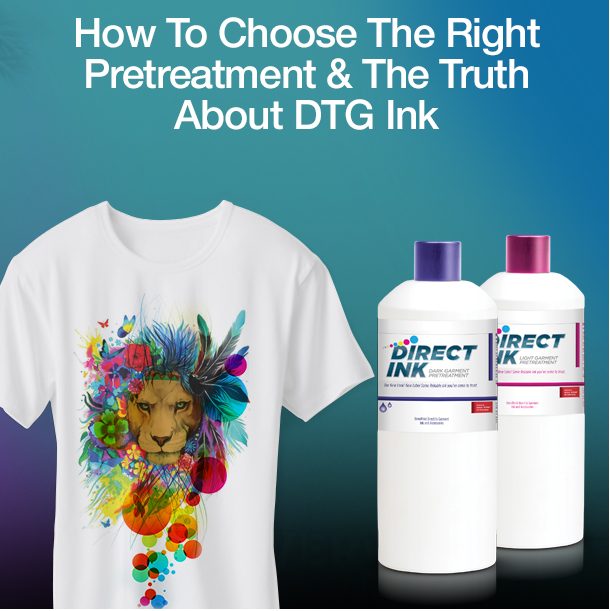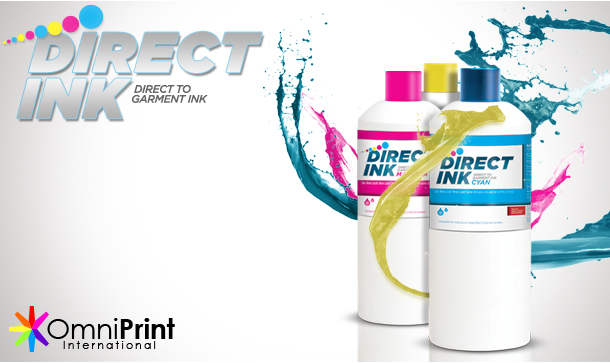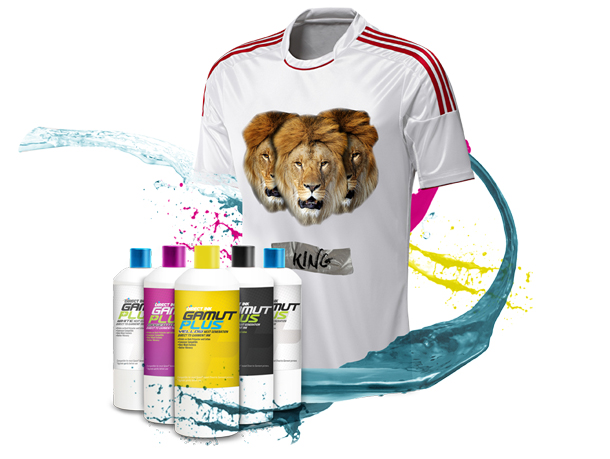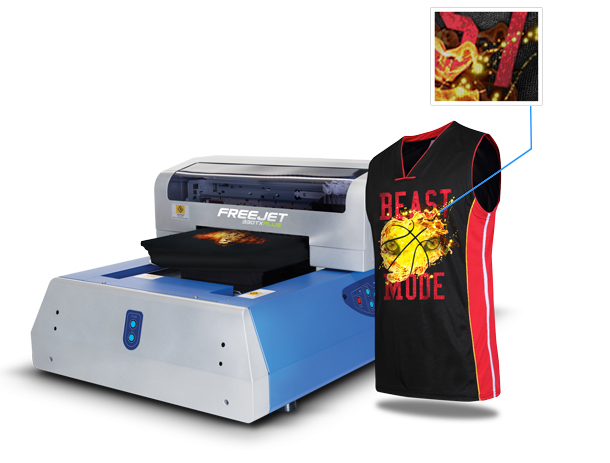Learn The Difference between Light and Dark
Garment Pretreatment, Which one to use for the job, and the importance of quality ink
Using the Right Pretreatment
It’s very common for new DTG users to be confused about whether to use light pretreatment or dark pretreatment. With a light pink shirt you would us light pretreat right? In most cases no – but it does also depend on the color of the image you are printing.
There is a very simple rule to remember: If you are printing any white ink you have to use dark pretreatment no matter the color of the shirt. In a way it should be called “White Ink” pretreatment but then it would get confused with white shirts. Let’s take a look at whens, whys and whats of Light and Dark pretreatment.
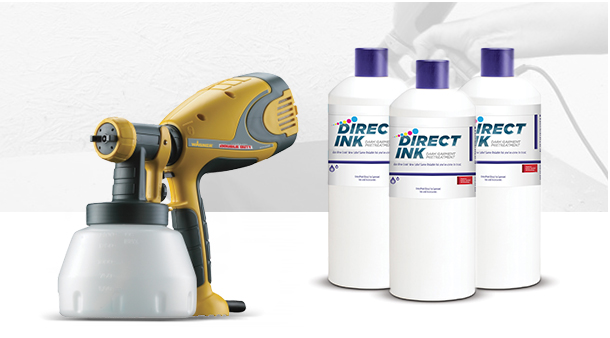
Light Pretreatment
Light garment pretreat is used mainly on white t-shirts or white material. Let’s begin with some history and understanding about printing on white shirts with using DTG (Direct-To-Garment) printers. Something you may not already know is that you do not really need to pretreat a white shirt. You will still get an ok print without pretreatment and some companies even use this as a selling point. Any machine can do this but the print quality, color and detail is night and day when compared to a pretreated garment.
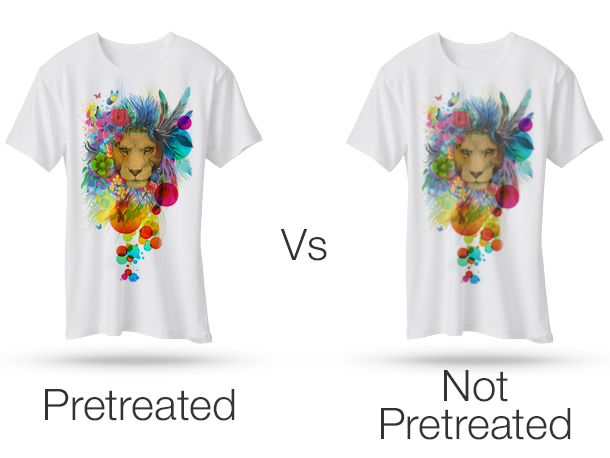
As I mentioned before the factor for when you use light or dark pretreatment boils down to one thing, are you printing white ink?
If any white ink is needed dark pretreat must be used. The factor is not the color of the shirt but the colors in the graphic you are printing.
So when and why would you use light pretreatment. A white shirt is most likely never going to need white ink printed on it so white garments are always going to use light pretreat. By pretreating a white shirt with light pretreat you will see a giant difference compared to no pretreatment. The colors will be much more vibrant and darker colors more solid and rich. You will also notice a higher quality of detail and no bleeding of color. The pretreatment will also act as a bonding agent when heat pressed and increase the washfast quality.
If you have the time print the same image on the front and back of a white shirt, pretreat one side and compare the two prints. You will see what a difference it makes.
Light pretreat can be used on other colors like pastels but the color in the image compared to the color of the shirt is going to be a giant factor. The rule of thumb for this is if the colors in the graphic to be printed are darker than the garment color then light pretreat and no white ink can be used. You have to imagine the following: if you are printing an image that is black, purple, blue and red on a pink shirt you can use light pretreat and no white. If the image is yellow, lime green and sky blue on a pink shirt it would need dark pretreat and white ink. Because the ink is transparent in nature the pink of the shirt would change the hue of those lighter colors. If the image has any white at all in it you would have to use dark pretreatment.
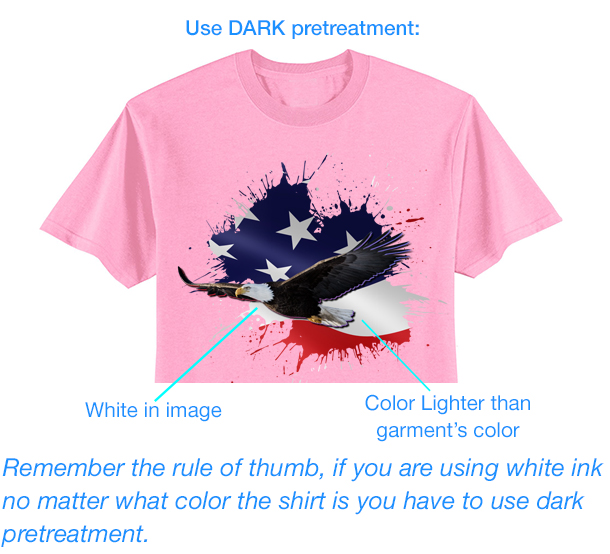
By now it should be very clear that Dark Pretreatment is used whenever you are printing white ink. Dark pretreatment is a different formula than light and performs a few more tasks. The first job of dark pretreat is to create a surface that white ink can be printed onto. Without pretreat white ink would absorb into the fabric, imagen pouring milk onto a t-shirt and that would be similar. When printed the white ink lands onto the shirt and starts to gel up when in contact with the pretreatment. This stops the ink from staying wet and forming puddles giving the color ink a surface to print on and not bleed or mix. When the shirt is put in the heat press the heat then activates the pretreatment as a bonding agent so the print can grab into the fibers and become one.
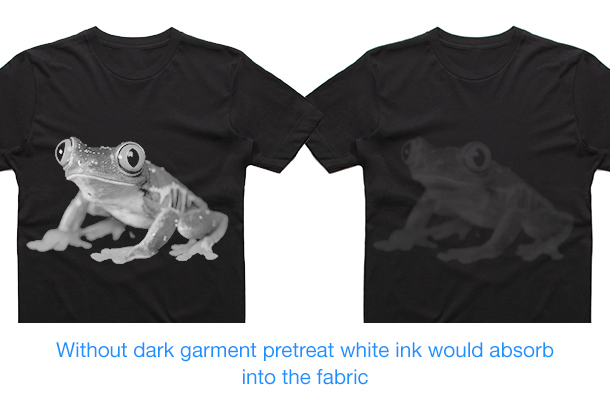
This is why light pretreatment will not work for white ink, it has a different need and formula. The same goes for dark pretreat on a white shirt, you should not use it. Although your print may look good the garment may begin to “yellow” once in the heat press and you may also wash quality.
In summary light pretreat is really only for white garments and dark pretreat is for anytime you print white ink regardless of garment color. One last point I would like to make is to always use the brand of pretreatment that matches the brand of ink you are using. This is the only way to guarantee quality prints and good wash results. Purchasing inks and pretreatments from the manufacturer of your printer will also guarantee that the product is a 100% real branded formula. This will become very important to the longevity of your printer and your product.
Inks and pretreatments are made to work together and mismatching brands could cause key ingredients in the formulas from working well. Keep in mind that using an ink not approved by the manufacturer may void your warranty.

The Truth About DTG INKS
There are many huge factors when it comes to direct-to- garment inks. The science that is involved in the inks we use for DTG printing is no joke. An ink can hit the market with a giant promotional give-away marketing plan and be given rave reviews. Three months down the road the same people start seemajor problems like clogged heads or deteriorated components. In most cases when it is found to be caused by the ink it is called a batch problem and has been fixed.
The major point is that DTG ink has to be made properly and with actual scientists with years of experience. There are only 3 places on the planet that make the pigment used for our inks. The pigment they do not use is sold to a secondary market to be used by other ink manufacturers. That right away says a lot about ink quality.
You could either be buying ink from the direct source or ink made from secondary
pigments.
When you are working with the major ink producers the quality control standards are at the
highest level. Any problems with ink production batches are not acceptable and the ink is pulled, never
to reach the public. Due to the size of these companies it can be considered loss and not impact them financially. Unfortunately other ink companies of smaller scale cannot afford to throw away gallons of ink and the bad batch still finds its way to the end user.

OmniPrint offers 2 different brands of ink for Direct to Garment printers. Both inks come from the direct source of ink manufacturers and have the quality and wash longevity created from over a decade of development. A “Bad Batch” will never be a problem and our customers will never become a unknowing test subject for ink development. Standards like this are why OmniPrint/FreeJet have won the SGIA product of the year for the last 2 years straight. The two inks available from OmniPrint are available as follows:
Direct Ink
Over the last decade this ink formula has been finely tuned to become the most dependable industry standard in performance and wash longevity. This ink is developed to work with most all Epson based/print head DTG printers. Direct ink is also the most affordable high quality ink on the market. This equates to such low print costs that your profits will eliminate any worry of whether or not you’re making any money on a print.
Direct Ink and FreeJet printers are so finely tuned together our prints are famously known for the best color match and detail in the industry.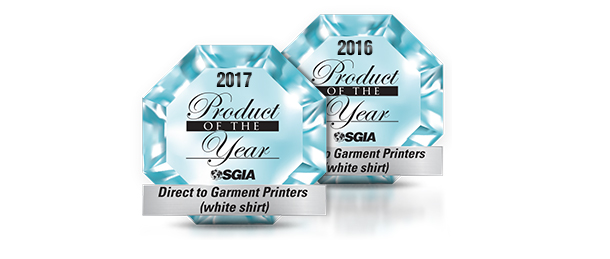
That is just one of the reasons Omniprint/FreeJet have won the SGIA Product of the Year award 2 years running. Price, quality and dependability are Direct Inks trifecta of success.
Gamut Plus
For over a decade direct to garment printers have been limited to cotton or cotton with a low polyester content at best. After years of hard research and development OmniPrint has created the
ultimate DTG inks and pretreatments. Gamut plus inks can print on light or dark 100% cotton to 100% polyester and anything in-between. There is also no change in print quality from one blend to another your prints will be vibrant and crisp. The wash longevity is on a new level of print life, the print will still look good while the shirt has now become great for waxing your car.
Made from the world finest high quality pigments Gamut Plus Inks are the only true DTG ink actually formulated to work on cotton and polyester for a professional resale product.
A few have made the claim to print on polyester but that is about as far as it goes, getting something to print and making something print are two different worlds. The difference being your customer not wanting a refund after the print washes off. The printing process is the same with only the pretreatment being the major change, a cotton or polyester solution must be used depending the material you are printing on.
No need to stand on one leg, hop, rub your belly and be disappointed when your print didn’t come out. Did you close one eye also? That must be why it didn’t work! We are very proud of the work we have done with a SGIA Product of the Year 2017 award for print quality to show for it. We stand behind our products so our customers can too. Take advantage of all the new customers you can now add to your list and goodbye to limitations.
-Paul Green
